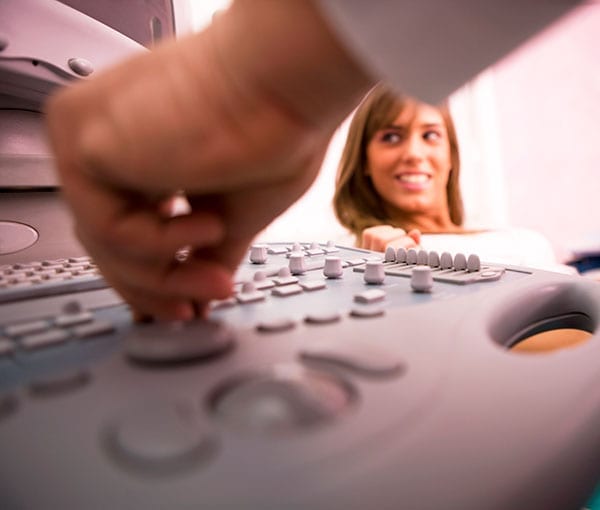The in-office exams help predict the extent of disease and the likely benefits of surgery as well as other treatments.
-Dr. Cook

As part of the diagnostic process in assessing your pelvic pain, Dr. Cook will perform a pelvic exam and an ultrasound. While he utilizes common techniques, he has specially adapted them to investigate the signs and symptoms of endometriosis and other sources of pelvic pain:
- The ultrasound is not only used to image the pelvic structures but also to map out any painful areas in the lower pelvis
- The pelvic exam consists of both a bimanual and a digital exam to help determine which components of your pain are uterine and which are non-uterine
- The speculum exam has been adapted in order to check for invasive disease of the vagina, a severe presentation of endometriosis that is often overlooked
These special techniques help predict the extent of disease and the likely benefits of surgery as well as other treatments.
What happens during the pelvic exam?
The pelvic exam that Dr. Cook will perform typically consists of several components:
During the pelvic exam, the abdomen is first examined for possible areas of tenderness. You may be asked to confirm whether pressure applied to different areas of your abdomen reproduces your pain.
This will be followed by the Q-tip test in which a Q-tip is lightly pressed against different points of the vulvar vestibule (the tissue around the vaginal opening) to check for any tenderness. Tenderness in this area would not be due to endometriosis but to another condition called vulva vestibulitis.
A bimanual exam will then be performed in which an external hand (on the abdomen) and internal finger(s) (inserted vaginally) will examine the size and motility of the reproductive organs (the uterus and ovaries). Restricted motility of the pelvic organs may suggest the presence of pelvic adhesions. In severe cases of endometriosis, the pelvic organs may become fused together by dense bands of scar tissue. The bimanual exam can also help establish whether there is any tenderness of the uterus. In order to identify and treat all forms of pelvic pain, it is important to differentiate between uterine and non-uterine pain.
After the bimanual exam, a digital vaginal exam will be performed, with the internal finger(s) only. This enables Dr. Cook to carefully palpate the structures between the uterus and bowel for any nodularity or tenderness. It is in this location that endometriosis is most commonly found, so any pain or nodularity in this area is highly suggestive of endometriosis. If the patient’s pain is reproduced during this exam, this is a good indication that surgery to remove these areas of painful tissue will help reduce or even fully relieve the pain.
Lastly, a speculum exam will be performed with the speculum tilted slightly downwards. In some patients with severe endometriosis, deep invasive disease has invaded from the pelvis through the wall of the vagina, just below the cervix. With this adapted positioning of the speculum, it is possible to detect the presence of invasive vaginal endometriosis. If vaginal endometriosis is present, this will be removed during surgery, just like any other area of disease.
What happens during the ultrasound exam?
During the transvaginal ultrasound, the ultrasound probe is inserted vaginally allowing the pelvic structures to be visualized on a computer screen. Much like the pelvic exam, Dr. Cook uses the probe to map out areas of pain by carefully palpating different parts of the pelvis and noting the patient’s facial expressions and feedback. As far as visualizing areas of disease, the ultrasound will detect the presence and consistency of ovarian cysts and possibly deep areas of endometriosis.

Areas of endometriosis deep within the ovary may not be detectable during surgery but can often be visualized by ultrasound, informing the surgeon in advance of its presence so that it can be removed. Superficial endometriosis, however, is too flat to be detected by imaging and is only visualized during surgery itself. Other gynecological conditions such as fibroids, pelvic varicosities, and structural uterine abnormalities may also be detected during the ultrasound exam.
From the front end, through the initial visit, the exam, and closing out by the reception, you feel validated and empowered.
-Lizzy
